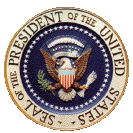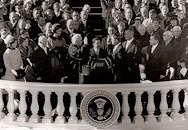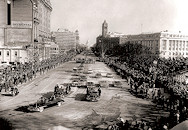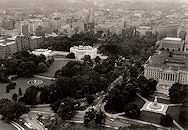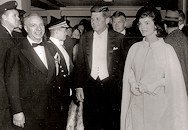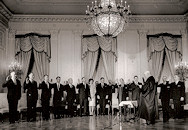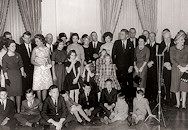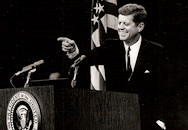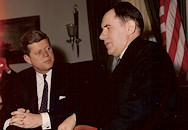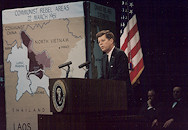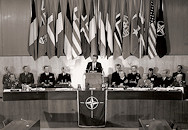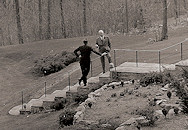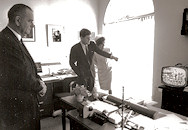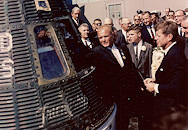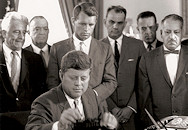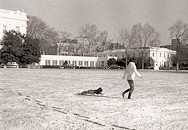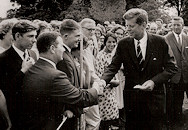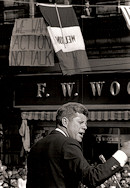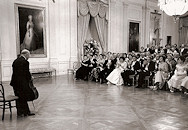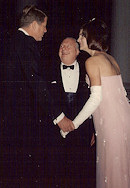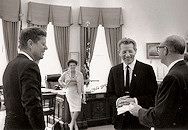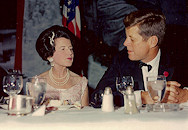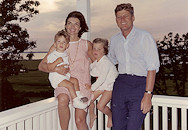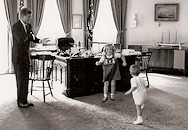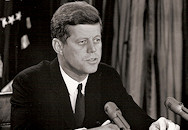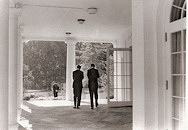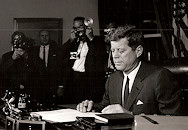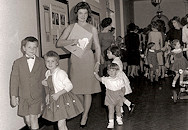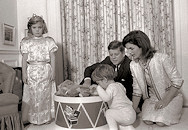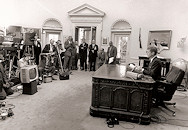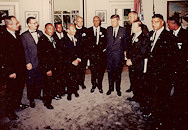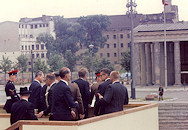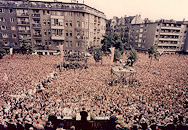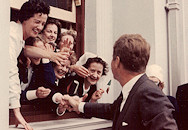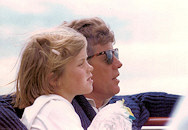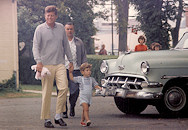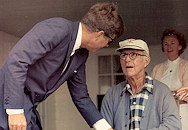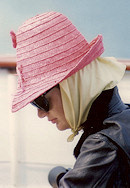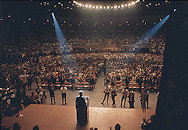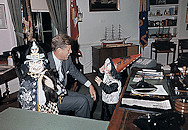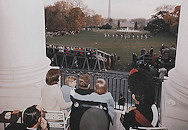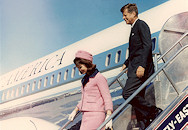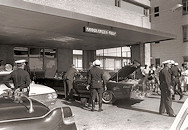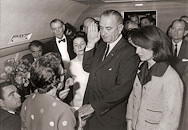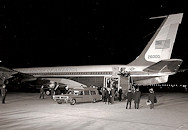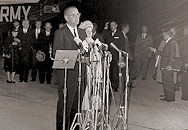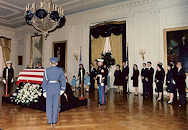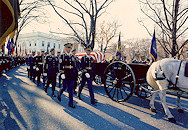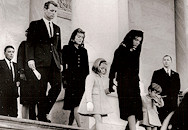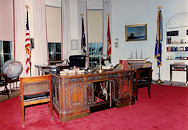![]()

![]()
John Fitzgerald Kennedy takes the oath of office and becomes the 35th President of the United States of America, January 20, 1961. At age 43, he is the youngest man and the first Roman Catholic ever elected, winning by one of the smallest margins of victory, only 115,000 popular votes. Lyndon B. Johnson, 51, is his Vice President.
Left - The new President's motorcade on Pennsylvania Avenue during the inaugural parade. Right - An aerial view of the Kennedy White House.
The President and First Lady, Jacqueline Bouvier Kennedy, arrive at one of numerous inaugural balls held in their honor. The festivities will last until nearly 4 a.m. the next day. Just before 9 a.m., after a few hours sleep, the President arrives at the Oval Office for his first day as chief executive.
First Day in Office. Left - The swearing-in of the Kennedy cabinet, featuring the controversial appointment of the President's younger brother Robert as U.S. Attorney General. Right - A group portrait of the extended Kennedy family along with Lyndon and Ladybird Johnson.
Just five days after taking office, the President holds his first news conference, televised live from the State Department auditorium. His easy-going style and quick wit instantly endear him to many reporters and to the American people watching at home.
From the beginning and throughout his presidency, international tensions and political conflicts are a major preoccupation. Left - His first meeting with Soviet Foreign Affairs minister, Andrei Gromyko. Mid - During a news conference discussing the problems of Laos in Southeast Asia, the President states, "The security of all Southeast Asia will be endangered if Laos loses its neutral independence." He orders more military aid including U.S. armed forces to the area. Right - Addressing the NATO chiefs of staff at the State Department he pledges a strengthening of conventional forces and an effective nuclear capability.
Following the Bay of Pigs debacle, a private conversation between President Kennedy and former President Eisenhower at Camp David, Maryland. April 22, 1961.
Bay of Pigs refers to the attempt made by over 1200 anti-Castro Cuban rebels to land on the southern coast of Cuba and overthrow the regime of Fidel Castro, April 17, 1961. Although trained and backed by the U.S. government, the invasion failed as the rebels were attacked by Cuban military forces and received no support from the U.S. military or anti-Castro people in Cuba. As a result, they were quickly defeated and put in prison, causing a major embarrassment to the Kennedy White House. At a press meeting on April 20th, the President deflected much of the criticism by commenting on some of the lessons he learned from the failed mission, saying "the forces of Communism are not to be underestimated."
Shortly after this, in early June, the President traveled to Vienna, Austria, where he met with Soviet Premier Nikita Khruschev for the first time. During two days of meetings, Khruschev sized-up the young President and underestimated his resolve, resulting later in the October Missile Crisis of 1962.
The Space Race. Left - The President, First Lady and Vice President watch Alan Shepard on television become the first U.S. astronaut by making a 15-minute suborbital flight, May 5, 1961. Following the later launch into orbit of John Glenn, the President visited Cape Canaveral in Florida and presented Glenn with NASA's Distinguished Service Medal. Right - Astronaut Glenn shows the President the space capsule in which he traveled into orbit and circled the earth three times.
In September 1962 the President delivered a speech at Rice University in which he pledged the U.S. would put a man on the moon "before the end of this decade." Seven years later, July 1969, Astronaut Neil Armstrong set foot on the moon.
At the request of his brother Robert, standing behind him, the President signs three tough new anti-crime bills targeting organized crime. The bills prohibit telephone betting, interstate transportation for purposes of racketeering and commercial transportation of betting equipment.
Winter of 1962. After a light snowfall, First Lady Jacqueline Kennedy treats John Jr. to a sled ride on the White House lawn.
Left - The President meets with eager young Peace Corps volunteers before they depart for Africa. Shortly after taking office, the President created the Peace Corps hoping to inspire young Americans to serve overseas in developing countries. Right - Cashing in on his popularity, the President makes a speech during an autumn campaign swing through several states to help Democrats in local 1962 elections.
Scenes from Camelot. Left - Renowned Spanish cellist Pablo Casals performs at the White House. Mid - During a formal White House dinner, an enchanted guest chats with the President and First Lady, who are now widely considered the most glamorous couple in the world. Right - Entertainer Danny Kaye chats with the President in the Oval Office while Judy Garland leans against the president's desk.
Left - Rose Kennedy and her son at the first awards ceremony for the Joseph P. Kennedy Jr. Foundation, which helps children in need. Mid - A very relaxed First Family at Hyannis Port in the summer of 1962. This picture was one of Jacqueline's favorites. Right - Fun in the Oval Office as the President encourages young Caroline and little John Jr. to dance.
October Missile Crisis. Left - After reviewing aerial photos indicating the placement of Russian missiles in Cuba, the President speaks to the nation on TV, October 22, 1962, and reports "unmistakable evidence...of offensive missile sites now in preparation...to provide a nuclear strike capability against the Western Hemisphere...It shall be the policy of this nation to regard any nuclear missile launched from Cuba...as an attack by the Soviet Union on the United States, requiring a full retaliatory response upon the Soviet Union." Mid - The President with his chief adviser, his brother Robert. Right - On October 23rd, the President signs a proclamation prohibiting shipments of missiles and other weapons to Cuba, and authorizing the U.S. military to intercept and search any ships heading toward Cuba. The whole world then waits to see what will happen. Days later, the Russians back down and agree to remove the missiles from Cuba if the U.S. will lift its naval blockade and guarantee no U.S. invasion of Cuba.
Amid the tremendous tension of international affairs, family life goes on at the White House. Left - The arrival of family and guests for Caroline's 5th birthday party. Right - The First Family including Caroline who is all dressed up for her birthday.
Civil Rights. Another preoccupation of the Kennedy White House is the struggle of African-Americans for equal treatment. On June 11, 1963, the President orders Alabama Governor George Wallace to cease and desist from obstructing black students from attending the University of Alabama. Left - That night, the President delivers a major televised address on civil rights. "It ought to be possible...for every American to enjoy the privileges of being American without regard to his race or color." Right - In August, leaders of the March on Washington, including Rev. Martin Luther King Jr. and Roy Wilkins, meet to discuss civil rights.
Europe 1963. Left - At the Berlin Wall, the President looks across at a guard from communist East Germany. Mid - In Berlin, the President speaks to the enormous crowd of Germans, telling them, "All free men, wherever they may live, are citizens of Berlin, and therefore, as a free man, I take pride in the words 'Ich bin ein Berliner.' (I am a Berliner)." From Germany, the President travels to Ireland for a three-day visit. Right - A group of Irish women thrilled to greet the Irish-American President.
Summer of 1963. Left - Caroline and her father enjoy the sea breeze at Hyannis Port during a boat ride. Mid - The President exits a candy store with John Jr. while carrying his toy animal. Right - President Kennedy bids farewell to family patriarch, Joseph P. Kennedy Sr. before boarding the helicopter to return to Washington.
The First Lady seen a few weeks after the death of her newborn son, Patrick Bouvier Kennedy, who died on August 9, 1963, just 39 hours after his birth. Born five weeks premature, the newborn died from resulting complications.
Left - The President speaking in Las Vegas during a five-day trip to Western U.S. states to encourage conservation of natural resources. September 28, 1963. Mid - A Halloween visit in the Oval Office from Caroline and John Jr. Right - On the south balcony of the White House, the President and his family enjoy a British bagpipe performance along with the ambassador of Great Britain. November 13, 1963.
Dallas. Arrival of the President and First Lady at Love Field, November 22, 1963. The presidential motorcade then leaves for a 45-minute trip downtown where the President is scheduled to speak to a meeting of the Citizens Council. The President and First Lady ride in an open-top limousine accompanied by Texas Governor John B. Connally and his wife. At 12:30 p.m. on Elm Street in downtown Texas the motorcade slowly approaches a triple underpass. Shots ring out. The President is struck in the back, then in the head and is mortally wounded. Gov. Connally is also struck.
At Parkland Memorial Hospital, the president's limo remains outside the emergency room where some fifteen doctors try in vain to save him. At 1 p.m. John Fitzgerald Kennedy is pronounced dead.
Left - At 2:38 p.m. on board Air Force One, Lyndon B. Johnson is sworn in as the 36th President of the United States while Jacqueline Kennedy observes. Air Force One then takes off with the body of the slain president aboard. Mid - Arrival at Andrews Air Force Base, Maryland, of the body of John Fitzgerald Kennedy. Right - President Johnson briefly addresses the nation from the Air Force Base, saying "I ask for your help and God's."
Left - The immediate family including Jacqueline, Caroline, John Jr., and Robert, view the closed casket in the East Room of the White House. Mid - The casket leaves the White House, taken to the Capitol building for public viewing. Right - The family leaves St. Mathews Cathedral after the funeral mass. The body is then taken to Arlington National Cemetery for burial.
The Oval Office of President Kennedy, now vacant and silent.
JFK Photo History
Early Years | War Hero | Politician | President
[ The History Place Main Page | American Revolution | Abraham Lincoln | U.S. Civil War | Child Labor in America 1908-1912 | Irish Potato Famine | The Rise of Adolf Hitler | The Triumph of Hitler | Defeat of Hitler | Timeline of World War II in Europe | Holocaust Timeline | Photo of the Week | This Month in History | Hollywood's Best History Movies ]
Copyright © 1996-2025 The History Place™ All Rights Reserved
Terms of use: Private home/school non-commercial, non-Internet re-usage only is allowed of any text, graphics, photos, audio clips, other electronic files or materials from The History Place.
|
|
|
|
